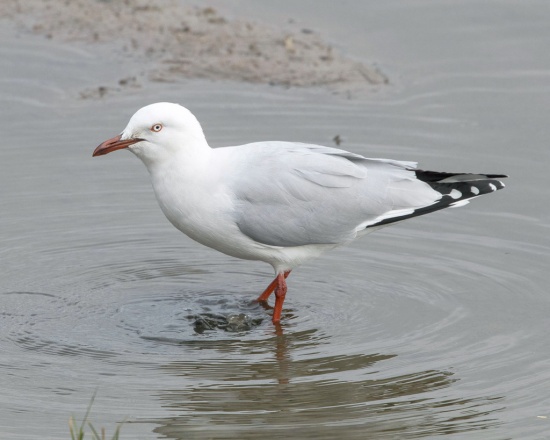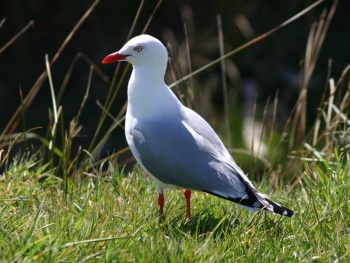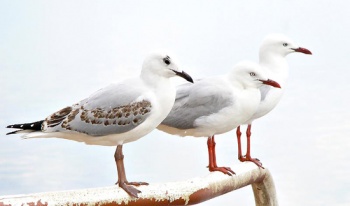(Video link) |
Nutcracker (talk | contribs) (more details) |
||
| Line 1: | Line 1: | ||
| − | [[Image: | + | [[Image:Silver Gull, Swanport.jpg|thumb|550px|right|Silver Gull ''C. n. novaehollandiae'', adult<br />Photo by {{user|peterday|Peter Day}}<br />Swanport Wetlands, Murray Bridge, Adelaide, South Australia, April 2016.]] |
;[[: Category:Chroicocephalus|Chroicocephalus]] novaehollandiae | ;[[: Category:Chroicocephalus|Chroicocephalus]] novaehollandiae | ||
''Larus novaehollandiae'' | ''Larus novaehollandiae'' | ||
==Identification== | ==Identification== | ||
| − | 40-45cm. White head, tail and underparts, with a light grey back and black-tipped | + | 40-45cm. White head, tail and underparts, with a light grey back and wings black-tipped with white 'mirrors'; bill, legs and eye-ring are bright orange-red. Iris white.<br /> |
The call is a high pitched, raucous ''scrark''. | The call is a high pitched, raucous ''scrark''. | ||
| + | |||
| + | ====Similar species==== | ||
| + | None within its Australian range, but in [[New Zealand]], care is needed to distinguish the rare [[Black-billed Gull]], which shares the white iris and unmarked white head, but has a slenderer black bill, slightly less black on the primaries, and in summer, also darker legs. Within the genus ''Chroicocephalus'', [[Slender-billed Gull]] also shares the white iris and unmarked white head, but does not occur anywhere nearby. | ||
| + | |||
==Distribution== | ==Distribution== | ||
| − | [[Image:Red- | + | [[Image:Red-billed Gull.jpg|thumb|350px|right|Red-billed Gull (''C. n. scopulinus'')<br />Photo by {{user|Janha|Janha}}<br />Invercargill, [[New Zealand]], October 2004.]] |
[[Australia]], [[New Zealand]] and surrounding islands. | [[Australia]], [[New Zealand]] and surrounding islands. | ||
| + | |||
==Taxonomy== | ==Taxonomy== | ||
| − | Three subspecies | + | As with other species of ''Chroicocephalus'', Silver Gull was formerly placed in the genus ''[[:Category:Larus|Larus]]''. |
| − | * ''C. n. forsteri'' in northern [[Australia]], [[New Caledonia]] and Loyalty Islands | + | |
| + | ====Subspecies==== | ||
| + | Three subspecies recognised, split into two species by Clements<sup>[[#References|1]]</sup> and formerly by IOC<sup>[[#References|2]]</sup>, but not more recently by IOC<sup>[[#References|3]]</sup> nor by Dickinson<sup>[[#References|4]]</sup> | ||
| + | * ''C. n. forsteri'' in northern [[Australia]], [[New Caledonia]], and the Loyalty Islands | ||
* ''C. n. novaehollandiae'' in southern [[Australia]] and [[Tasmania]] | * ''C. n. novaehollandiae'' in southern [[Australia]] and [[Tasmania]] | ||
| − | * ''C. n. scopulinus'' in [[New Zealand]], Chatham, Auckland and adjacent islands | + | * ''C. n. scopulinus'' ('''Red-billed Gull'''; syn. ''C. scopulinus'') in [[New Zealand]], Chatham, Auckland and adjacent islands |
| − | Some authorities | + | |
| − | + | Some authorities also recognise ''C. n. gunni'' in Tasmania, but it intergrades clinally with ''C. n. novaehollandiae''<sup>[[#References|5]]</sup>. | |
| + | |||
==Habitat== | ==Habitat== | ||
| − | Near water | + | [[Image:Silver_Gulls.jpg|thumb|350px|right|''C. n. novaehollandiae'', first-winter (front) & two adults.<br />Photo by Neil Fifer<br /> Sydney, Australia.]] |
| + | Near water, both coastal and inland wetlands, but more numerous on the coast. | ||
| + | |||
==Behaviour== | ==Behaviour== | ||
It is a scavenger; its diet also includes worms, fish, insects and crustaceans. | It is a scavenger; its diet also includes worms, fish, insects and crustaceans. | ||
They nest in large colonies on offshore islands. Two broods are often raised in a year. Both sexes share nest-building, incubation and feeding duties. 3 eggs are laid in a shallow nest scrape, lined with vegetation. | They nest in large colonies on offshore islands. Two broods are often raised in a year. Both sexes share nest-building, incubation and feeding duties. 3 eggs are laid in a shallow nest scrape, lined with vegetation. | ||
| + | |||
| + | ==References== | ||
| + | #{{Ref-Clements6thAug16}}#{{Ref-GillDonsker10}}#{{Ref-GillDonsker16V6.4}}#{{Ref-HM04}}#{{Ref-HBWVol3}} | ||
==External Links== | ==External Links== | ||
| Line 28: | Line 42: | ||
<br /> | <br /> | ||
{{Video|Red_billed_Gull Use Red-billed Gull to}} | {{Video|Red_billed_Gull Use Red-billed Gull to}} | ||
| − | |||
[[Category:Birds]] [[Category:Chroicocephalus]] [[Category:Videos]] | [[Category:Birds]] [[Category:Chroicocephalus]] [[Category:Videos]] | ||
Revision as of 15:09, 27 March 2017

Photo by Peter Day
Swanport Wetlands, Murray Bridge, Adelaide, South Australia, April 2016.
- Chroicocephalus novaehollandiae
Larus novaehollandiae
Identification
40-45cm. White head, tail and underparts, with a light grey back and wings black-tipped with white 'mirrors'; bill, legs and eye-ring are bright orange-red. Iris white.
The call is a high pitched, raucous scrark.
Similar species
None within its Australian range, but in New Zealand, care is needed to distinguish the rare Black-billed Gull, which shares the white iris and unmarked white head, but has a slenderer black bill, slightly less black on the primaries, and in summer, also darker legs. Within the genus Chroicocephalus, Slender-billed Gull also shares the white iris and unmarked white head, but does not occur anywhere nearby.
Distribution
Australia, New Zealand and surrounding islands.
Taxonomy
As with other species of Chroicocephalus, Silver Gull was formerly placed in the genus Larus.
Subspecies
Three subspecies recognised, split into two species by Clements1 and formerly by IOC2, but not more recently by IOC3 nor by Dickinson4
- C. n. forsteri in northern Australia, New Caledonia, and the Loyalty Islands
- C. n. novaehollandiae in southern Australia and Tasmania
- C. n. scopulinus (Red-billed Gull; syn. C. scopulinus) in New Zealand, Chatham, Auckland and adjacent islands
Some authorities also recognise C. n. gunni in Tasmania, but it intergrades clinally with C. n. novaehollandiae5.
Habitat
Near water, both coastal and inland wetlands, but more numerous on the coast.
Behaviour
It is a scavenger; its diet also includes worms, fish, insects and crustaceans.
They nest in large colonies on offshore islands. Two broods are often raised in a year. Both sexes share nest-building, incubation and feeding duties. 3 eggs are laid in a shallow nest scrape, lined with vegetation.
References
- Clements, J. F., T. S. Schulenberg, M. J. Iliff, D. Roberson, T. A. Fredericks, B. L. Sullivan, and C. L. Wood. 2016. The eBird/Clements checklist of birds of the world: v2016, with updates to August 2016. Downloaded from http://www.birds.cornell.edu/clementschecklist/download/
- Gill, F and D Donsker (Eds). 2010. IOC World Bird Names (version 2.7). Available at http://www.worldbirdnames.org/.
- Gill, F and D Donsker (Eds). 2016. IOC World Bird Names (version 6.4). Available at http://www.worldbirdnames.org/.
- Dickinson, EC, ed. 2014. The Howard and Moore Complete Checklist of the Birds of the World. 4th ed. Princeton: Princeton Univ. Press. ISBN 978-0956861122
- Del Hoyo, J, A Elliot, and J Sargatal, eds. 1996. Handbook of the Birds of the World. Volume 3: Hoatzin to Auks. Barcelona: Lynx Edicions. ISBN 978-8487334207
External Links





